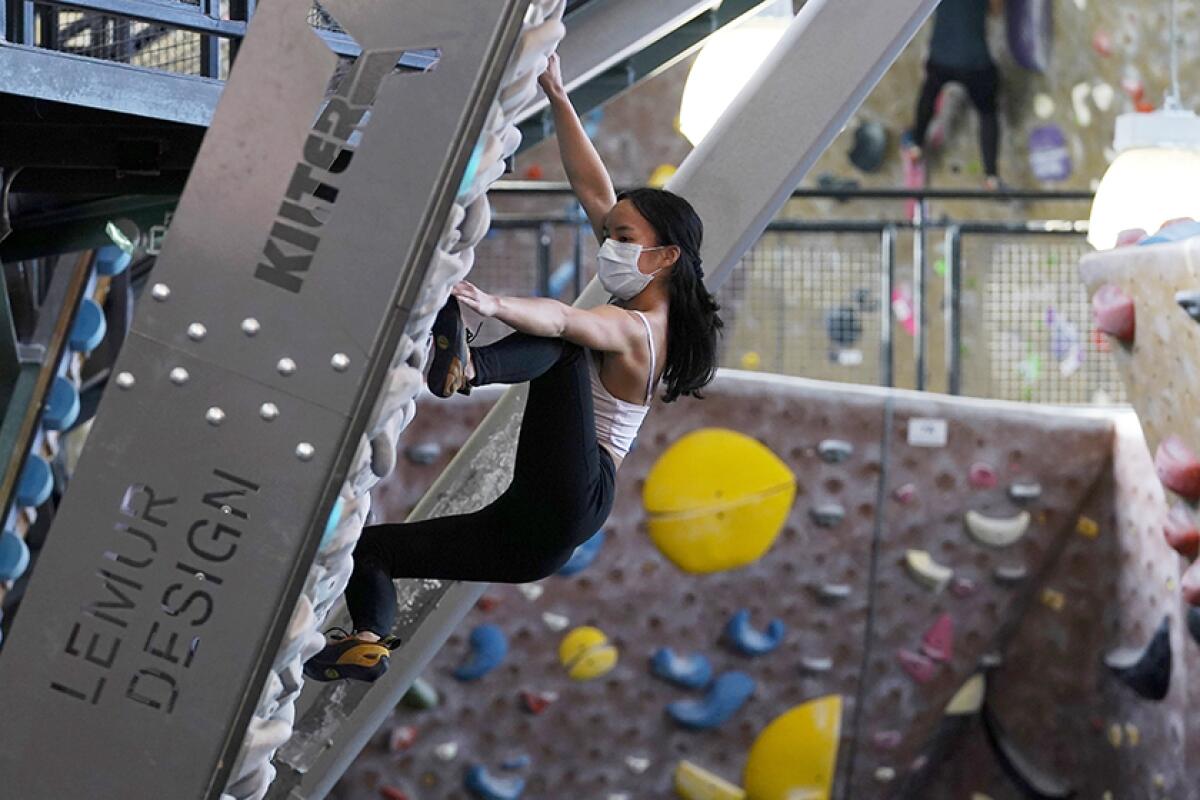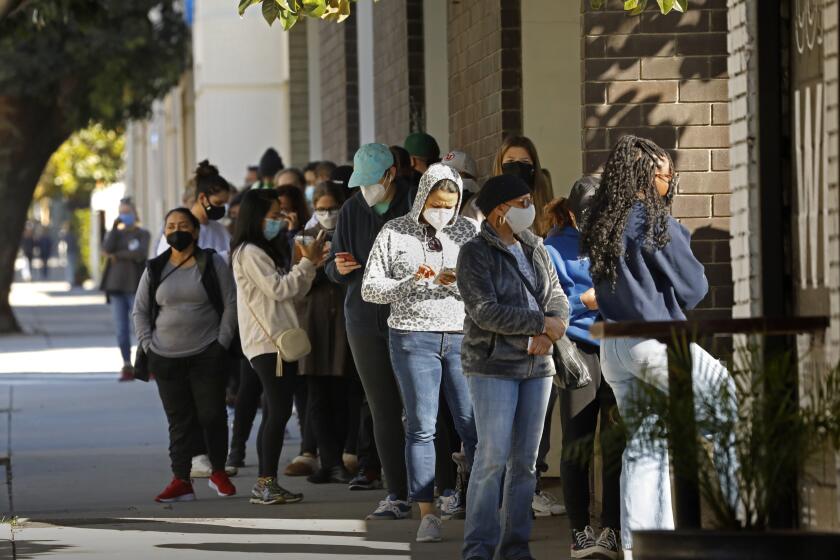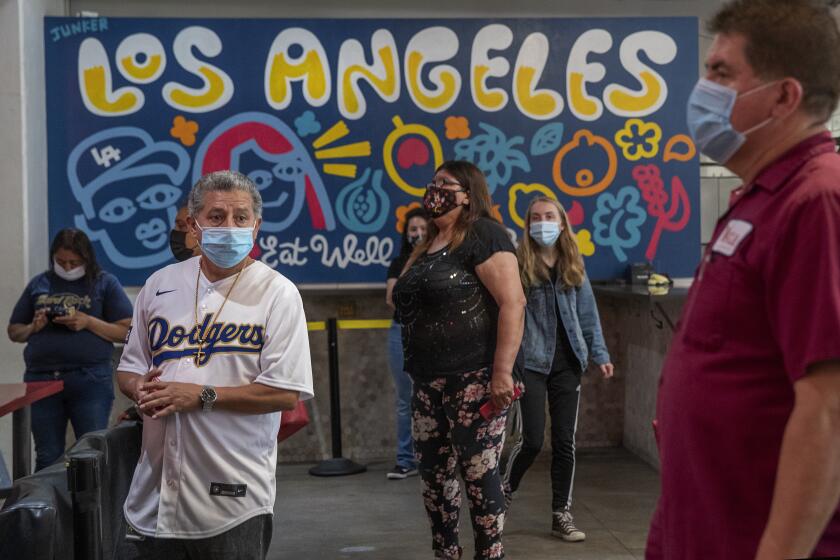Most of Bay Area will lift indoor mask order, citing falling COVID-19 risk

- Share via
SAN FRANCISCO — Most of the San Francisco Bay Area will lift local indoor mask rules next week, with officials saying that the COVID-19 danger has fallen enough to safely take the crucial step.
Along with Los Angeles County, the Bay Area has long had some of the strictest masking requirements in the state. But many officials there have decided now is the time to relax local mask orders for indoor public spaces for vaccinated people, although they continue to strongly recommend mask-wearing. Only Santa Clara County, home to Silicon Valley, is keeping indoor mask rules in the region for now.
“We are able to take this next major step of removing the universal indoor mask requirement because we have laid a strong foundation in good public health protections and know we can prevent severe illness, hospitalizations and deaths,” Dr. Susan Philip, San Francisco’s health officer, said in a statement.
California officials have said they will allow a statewide mask order for indoor public spaces to expire Tuesday, allowing counties to drop the mask mandate for vaccinated people in indoor public spaces on Wednesday. Unvaccinated individuals older than 2 will continue to be required to wear masks in all indoor public settings statewide.
And other masking orders will still apply, such as in healthcare settings, on public transportation and in K-12 schools and child-care settings.
Gov. Gavin Newsom also said the state should, in the coming days, make a public announcement regarding mask-wearing in public schools as well as release an “endemic plan” outlining strategies for the next phase of the battle against COVID-19.
But a top priority — both now and moving forward — remains getting more Californians vaccinated, as well as boosted when they are eligible.
“We are humbled in the face of this disease in all its forms and manifestations, mindful that it is not extinguished, it’s not yet behind us, mindful we still have a lot of work to do to convince people that they should still get vaccinated, let alone boosted,” Newsom said.
While they are dropping fast, case rates are still high in the Bay Area — about 680 cases a week for every 100,000 residents, according to a Times analysis, still far above the U.S. Centers for Disease Control and Prevention’s threshold for recommending indoor public mask-wearing for vaccinated people, which is 50 cases a week for every 100,000 residents. L.A. County’s rate is in the same ballpark, at about 620 cases a week for every 100,000 residents.
L.A. County is taking a more cautious approach to easing its mask order, noting that the county is still recording high coronavirus transmission rates.
But the Bay Area’s hospitals weren’t hit as hard as Southern California’s in the latest winter wave, and vaccination and booster rates in this region are among the highest in the state. In Santa Clara County, 84% of its residents are considered fully vaccinated. In San Francisco, that number is 82%, and in L.A. County, 69%.
One-third of L.A. County residents of all ages have received a booster shot, while more than half of San Francisco and Santa Clara County residents have received the additional dose.
“Omicron was an immense stress test on our system, and although it presented many difficulties because of the sheer number of people who became infected, we made it through with schools and businesses open and without overwhelming our hospitals because we have built up strong defenses against the virus with our high vaccination and booster rates,” Philip said.
Health officials in the Bay Area still advise vaccinated people to wear a mask when around others while indoors. “Wearing a mask in indoor public settings and in crowded settings is still a good idea and something we strongly recommend,” the San Mateo County health officer, Dr. Scott Morrow, said in a statement.
Santa Clara County, Northern California’s most populous county, will continue a local indoor mask order, aligning with the approach of Los Angeles County, where health officials agreed that it’s too early to lift a mask order in indoor public spaces.
Based on current trends, Santa Clara County health officials expect they will meet revised criteria to lift their mask mandate by early March. L.A. County is on track to lift its local indoor mask mandate between late March and late April, according to a Times analysis of trends.
COVID-19 will never go away, but the pandemic will be over when the disease becomes ‘endemic.’ Here’s what that means.
“We still have very high levels of community transmission — still higher than at any other point in the pandemic, pre-Omicron. And so, the risk of being exposed to someone with COVID in our community is still high,” Dr. Sara Cody, the Santa Clara County public health director and health officer, said at a press briefing. “We cannot lift the indoor mask requirement with community transmission as high as it is right now.”
Santa Clara County is reporting about 500 cases a week for every 100,000 residents, which is about 1,400 coronavirus cases a day, state data show. According to data Cody provided, officials will wait for the case rate to fall to 200 cases a week for every 100,000 residents — which is 550 cases a day for Santa Clara County — and remain there for one week.
Santa Clara County also wants to wait until coronavirus-positive hospitalizations remain low and steady. “We’ve not yet met this metric as our hospitalizations have plateaued, but are not yet on their way down, though we do hope and expect to see them trending that way very soon,” Cody said.
Los Angeles County is waiting for case rates to fall to 50 a week for every 100,000 residents, which is 730 cases a day in the county, and remain below that level for two weeks. Based on current trends of cases falling in half every week, L.A. County is on track to reach that threshold in early March, meaning it’s plausible L.A. County’s indoor mask mandate could be dropped by late March.
Even as California’s mask order is set to expire next week, health officials are still encouraging people to wear masks while transmission rates are up.
Dr. George Rutherford, a UC San Francisco epidemiologist, said it was reasonable for Los Angeles and Santa Clara counties to retain their mask mandates, even as other counties choose to go with policies as lenient as the state allows.
Compared with the rest of the Bay Area’s most-populated counties, Santa Clara County has one of the higher case rates. Its rate of 500 cases a week for every 100,000 residents is 20% higher than the second- and third-most populated counties in the Bay Area — Alameda and Contra Costa counties — which have rates of about 415 cases a week for every 100,000 residents.
Dr. Kirsten Bibbins-Domingo, chair of UC San Francisco’s Department of Epidemiology and Biostatistics, agreed, saying: “I can understand for larger counties why your margin is going to be somewhat different.
“All of this relies on: When we take our masks off, we know we will see some bump in transmission,” Bibbins-Domingo said. “And the question is, you know, what the capacity is in the [hospital] system to deal with that?”
It’s also reasonable for the smaller Bay Area counties to drop their local indoor mask mandate, Rutherford said: “That’s a judgment call about how it fits best with the local epidemiology.”
It’s likely that many Bay Area residents will continue wearing masks anyway in indoor public settings, Bibbins-Domingo said. “In our region, we have more people who will be more cautious. And that probably makes it easier in our environment to say, ‘Yeah, we can get rid of this mandate,’” she said.
Rutherford, however, did suggest a more cautious approach in retaining mask mandates for harder-hit areas of the state, such as the San Joaquin Valley, where local mask mandates are politically difficult to implement. Hospitals remain quite strained there.
Health officials and experts still suggested that people who want to avoid getting infected — especially those who are elderly or with underlying health conditions — still be cautious as mask mandates ease, noting that transmission remains high.
Dining at restaurants outdoors remains safer than in indoors, and risk can be reduced inside by eating near a window, Dr. Regina Chinsio-Kwong, a deputy health officer for Orange County, said. Chinsio-Kwong hasn’t yet returned to working out at a gym, but she said that people will have to make their own choices about what risks they want to take as transmission dips but remains at high levels.
“If you’re someone who was boosted and has low risk of severe infection, and you’re not around others who may be high risk, you may decide for yourself that it’s important for you to exercise and maybe not wear a mask indoors in the gym. But again, everybody will have to make that decision for themselves,” Chinsio-Kwong said. Orange County will align with the state next Wednesday and won’t have a local indoor mask mandate in public settings.
Some experts will remain cautious for a while longer. Bibbins-Domingo said she doesn’t plan on dining at a restaurant “quite anytime soon.” But in general, she said she expects her comfort level will increase as case counts continue falling.
“We’re all navigating our own comfort level with these decisions, and they are a little bit about understanding our own individual risk, about the risk in the environment that we’re in, and how much we want to do those things,” she said. “We will all be doing that calculation all the time. Luckily, we’re doing it in an environment where the cases are plummeting.”
In announcing the plan to relax California’s indoor masking rule, state officials noted that the numbers of newly confirmed coronavirus cases and hospitalized COVID-19 patients are down significantly from last month’s surge-time heights.
“We’re moving in the right direction,” Newsom said during a bill-signing ceremony Wednesday.
Though he said he thinks “broadly, we’re moving in a direction that will be embraced by the vast majority of cities and counties in this state over the coming weeks,” Newsom added that some areas may elect for a different near-term approach.
“We’ve made tremendous progress, and that progress is exampled all across the state of California — but not equally,” he said. “And as a consequence of that, in consideration of such, California has always established itself from the bottom up. One size does not fit all. We have basic mandates in terms of minimum expectations, but we allow local control. We allow local decisions to be made.”
More to Read
Sign up for Essential California
The most important California stories and recommendations in your inbox every morning.
You may occasionally receive promotional content from the Los Angeles Times.

















